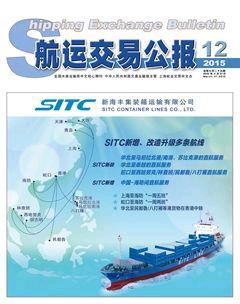Weekly Commentary on China Containerized Transportation
Liu+Zijia
In the week ending March 20, China export box market keeps flat overall, causing spot rate and comprehensive index slip largely. On March 20, China (Containerized) Freight Index (CCFI) issued by Shanghai Shipping Exchange (SSE) quotes 1034.29 points, falling by 3.2% from one week ago; while Shanghai (Containerized) Freight Index (SCFI) issued by SSE dives by 7.5% against last week.
Cargo volume in the Europe service keeps flat, on one hand, most plants have not been recovered from holiday; on the other hand, impacted by the inflation of Europe exchange, demand is weak to increase in the receipt region, and transport demand in the Europe service keeps flat. The average slot utilization rate in this service stands to be 65%. In order to attract more cargo volume, most box liners have to reduce freight rate, with some even below USD500 per TEU. On March 20, freight index in the China-Europe service quotes 1251.93 points, down by 3.8% from one week ago. In the Mediterranean service, cargo volume is weak to improve, where the average slot utilization rate is below 70%. Competition among spot rates tends to be more intensified, causing spot rate declining more than that in the Europe service. On March 20, freight index in the China-Mediterranean service falls by 5.2% from last week to 1392.32 points.
In the North America service, the U.S. economy keeps improving recently, which boosts transport demand improving stably. In the USWC service, as Southwest ports become more effective, the average slot utilization rate declines to be around 75%. In the USEC service, the relatively high spot rate spurs box liners expanding capacity supply. Box liners have increased several extra services, causing the average slot utilization rate falling to be around 80%. Considering that the oversupply of capacity is deteriorated, most box liners have to delay the freight rate increase plan from mid March, with spot rate on the downward trend since Feb. On March 20, freight rate in the services from Shanghai to USWC and USEC (covering seaborne surcharges) quote USD1748 per FEU and USD4355 per FEU, both down by 4.7% from last week. Cargo volume has a slight recovery in the Persian Gulf/Red Sea service. As the unbalanced demand/supply condition worsens, the average slot utilization rate stands around 75%, with spot rate slipping. On March 20, freight index in the China-Persian Gulf/New Zealand service quotes 1013.57 points, down by 2.3% from one week ago.
Transport demand has no improvement in the Australia/New Zealand service. Despite most box liners holding on carrying out service-ceasing plan in successions, the average slot utilization rate hovers between 70-80%, with spot rate keeping slip since from mid Jan. On March 20, freight rate in the Shanghai-Australia/New Zealand service (covering seaborne surcharges) quotes USD492 per TEU, decreasing 7.5% from one week ago.endprint
In the South America service, impacted by worsened inflation and exchange depreciation, residences consumer demand is stroked by, which dampens the cargo volume in the South America from jump. Furthermore, as part box liners expand the capacity supply, demand/supply condition has no remarkable improvement, with spot rate tumbling largely. On March 20, freight rate in the Shanghai to South America service (covering seaborne surcharges) dived by 11.6% compared with one week ago to USD580 per TEU.
(Please contact the Information Dept of SSE for more details.)
SHIPPING EXCHANGE BULLETIN
TOTAL EDITION: 925
31/3/2015
CONTENT FOR THIS WEEK
STX Dalian Is Struggling
The Whole Story of Labor Dispute in USWC Ports
Tianjin Port Embraces Development under the
Integration of Jin-Jing-Ji Policy
OOCL Posts Net Profit as Usual
Logistics Industry Faces New Development via Internet
Drilling Platform Market Enters Freeze Periodendprint

